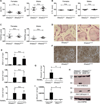The collection of NFATc1-dependent transcripts in the osteoclast includes numerous genes non-essential to physiologic bone resorption
- PMID: 22985540
- PMCID: PMC3457000
- DOI: 10.1016/j.bone.2012.08.113
The collection of NFATc1-dependent transcripts in the osteoclast includes numerous genes non-essential to physiologic bone resorption
Abstract
Osteoclasts are specialized secretory cells of the myeloid lineage important for normal skeletal homeostasis as well as pathologic conditions of bone including osteoporosis, inflammatory arthritis and cancer metastasis. Differentiation of these multinucleated giant cells from precursors is controlled by the cytokine RANKL, which through its receptor RANK initiates a signaling cascade culminating in the activation of transcriptional regulators which induce the expression of the bone degradation machinery. The transcription factor nuclear factor of activated T-cells c1 (NFATc1) is the master regulator of this process and in its absence osteoclast differentiation is aborted both in vitro and in vivo. Differential mRNA expression analysis by microarray is used to identify genes of potential physiologic relevance across nearly all biologic systems. We compared the gene expression profile of murine wild-type and NFATc1-deficient osteoclast precursors stimulated with RANKL and identified that the majority of the known genes important for osteoclastic bone resorption require NFATc1 for induction. Here, five novel RANKL-induced, NFATc1-dependent transcripts in the osteoclast are described: Nhedc2, Rhoc, Serpind1, Adcy3 and Rab38. Despite reasonable hypotheses for the importance of these molecules in the bone resorption pathway and their dramatic induction during differentiation, the analysis of mice with mutations in these genes failed to reveal a function in osteoclast biology. Compared to littermate controls, none of these mutants demonstrated a skeletal phenotype in vivo or alterations in osteoclast differentiation or function in vitro. These data highlight the need for rigorous validation studies to complement expression profiling results before functional importance can be assigned to highly regulated genes in any biologic process.
Copyright © 2012 Elsevier Inc. All rights reserved.
Figures






Similar articles
-
PDK1 is important lipid kinase for RANKL-induced osteoclast formation and function via the regulation of the Akt-GSK3β-NFATc1 signaling cascade.J Cell Biochem. 2020 Nov;121(11):4542-4557. doi: 10.1002/jcb.29677. Epub 2020 Feb 12. J Cell Biochem. 2020. PMID: 32048762
-
TGFβ1 Regulates Human RANKL-Induced Osteoclastogenesis via Suppression of NFATc1 Expression.Int J Mol Sci. 2020 Jan 25;21(3):800. doi: 10.3390/ijms21030800. Int J Mol Sci. 2020. PMID: 31991837 Free PMC article.
-
Ca2+-Dependent Regulation of NFATc1 via KCa3.1 in Inflammatory Osteoclastogenesis.J Immunol. 2018 Jan 15;200(2):749-757. doi: 10.4049/jimmunol.1701170. Epub 2017 Dec 15. J Immunol. 2018. PMID: 29246953 Free PMC article.
-
NFATc1: functions in osteoclasts.Int J Biochem Cell Biol. 2010 May;42(5):576-9. doi: 10.1016/j.biocel.2009.12.018. Epub 2009 Dec 24. Int J Biochem Cell Biol. 2010. PMID: 20035895 Review.
-
Epigenetic and transcriptional regulation of osteoclast differentiation.Bone. 2020 Sep;138:115471. doi: 10.1016/j.bone.2020.115471. Epub 2020 Jun 8. Bone. 2020. PMID: 32526404 Review.
Cited by
-
Rab GTPases in Osteoclastic Endomembrane Systems.Biomed Res Int. 2018 Aug 15;2018:4541538. doi: 10.1155/2018/4541538. eCollection 2018. Biomed Res Int. 2018. PMID: 30186859 Free PMC article. Review.
-
NHA2 promotes cyst development in an in vitro model of polycystic kidney disease.J Physiol. 2019 Jan;597(2):499-519. doi: 10.1113/JP276796. Epub 2018 Oct 17. J Physiol. 2019. PMID: 30242840 Free PMC article.
-
MYC-dependent oxidative metabolism regulates osteoclastogenesis via nuclear receptor ERRα.J Clin Invest. 2017 Jun 30;127(7):2555-2568. doi: 10.1172/JCI89935. Epub 2017 May 22. J Clin Invest. 2017. PMID: 28530645 Free PMC article.
-
Effect of r-Mt-Cpn10 on human osteoblast cells.Int J Clin Exp Med. 2014 Sep 15;7(9):2779-86. eCollection 2014. Int J Clin Exp Med. 2014. PMID: 25356139 Free PMC article.
-
Rab32 and Rab38 maintain bone homeostasis by regulating intracellular traffic in osteoclasts.Cell Struct Funct. 2023 Nov 17;48(2):223-239. doi: 10.1247/csf.23061. Epub 2023 Nov 10. Cell Struct Funct. 2023. PMID: 37793839 Free PMC article.
References
-
- Sims NA, Gooi JH. Bone remodeling: Multiple cellular interactions required for coupling of bone formation and resorption. Semin Cell Dev Biol. 2008;19:444–451. - PubMed
-
- Miller PD. Denosumab: anti-RANKL antibody. Curr Osteoporos Rep. 2009;7:18–22. - PubMed
-
- Kendler DL, Roux C, Benhamou CL, Brown JP, Lillestol M, Siddhanti S, Man HS, San Martin J, Bone HG. Effects of denosumab on bone mineral density and bone turnover in postmenopausal women transitioning from alendronate therapy. J Bone Miner Res. 2010;25:72–81. - PubMed
-
- Woo SB, Hellstein JW, Kalmar JR. Narrative [corrected] review: bisphosphonates and osteonecrosis of the jaws. Ann Intern Med. 2006;144:753–761. - PubMed
Publication types
MeSH terms
Substances
Grants and funding
- R01 NS020498/NS/NINDS NIH HHS/United States
- DC04156/DC/NIDCD NIH HHS/United States
- HHMI/Howard Hughes Medical Institute/United States
- R01AR060363/AR/NIAMS NIH HHS/United States
- K08 AR062590/AR/NIAMS NIH HHS/United States
- HL55520/HL/NHLBI NIH HHS/United States
- K08 AR054859/AR/NIAMS NIH HHS/United States
- R01 AR060363/AR/NIAMS NIH HHS/United States
- R01 DC004156/DC/NIDCD NIH HHS/United States
- R01 HL055520/HL/NHLBI NIH HHS/United States
- P30 AR046032/AR/NIAMS NIH HHS/United States
- K08AR054859/AR/NIAMS NIH HHS/United States
LinkOut - more resources
Full Text Sources
Molecular Biology Databases
Miscellaneous

